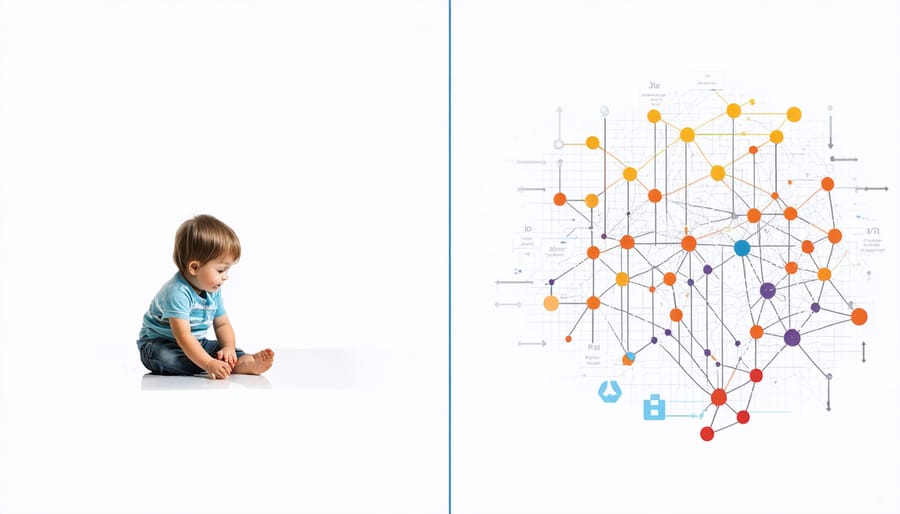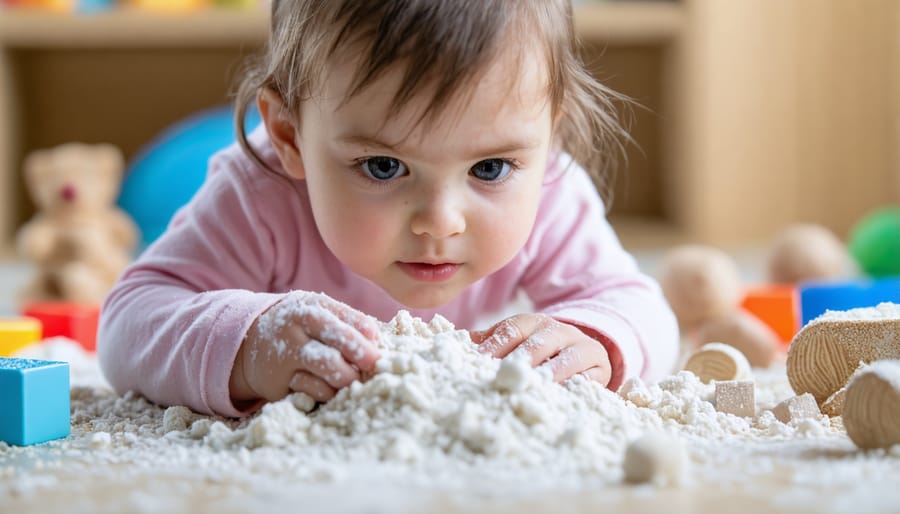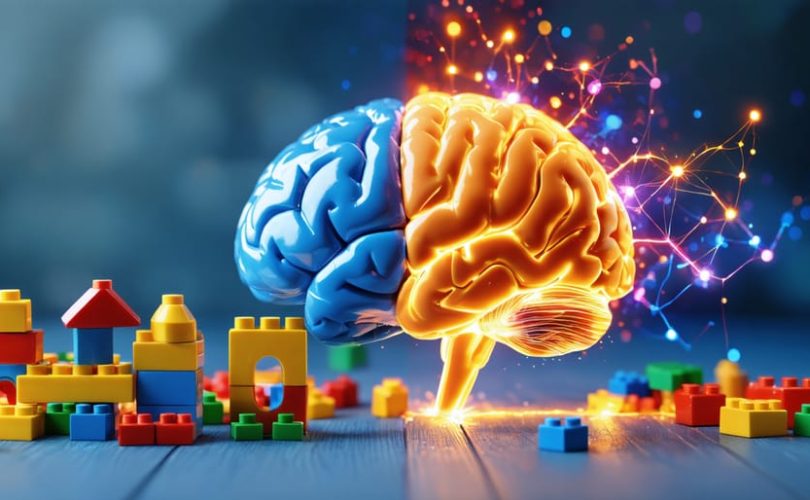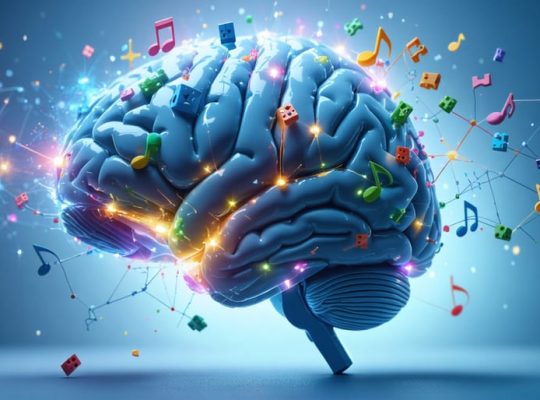When your child builds with blocks or creates imaginative stories during playtime, they’re not just having fun – they’re actively participating in a fascinating intersection of psychology and neuroscience. Every playful moment rewires your child’s brain, creating new neural pathways that shape their emotional, cognitive, and social development.
The relationship between psychology and neuroscience is like two sides of the same coin – while psychology helps us understand behavior and mental processes, neuroscience reveals the biological mechanisms behind these experiences. Together, they provide a complete picture of how our children’s minds develop and function.
As parents and caregivers, understanding this connection helps us make informed choices about our children’s daily activities. When we recognize that each game of peek-a-boo strengthens neural connections and every shared story builds emotional resilience, we can approach playtime not just as entertainment, but as vital building blocks for healthy brain development.
This powerful partnership between psychology and neuroscience continues to unveil new insights about childhood development, offering practical ways to support our children’s growth through purposeful play and meaningful interactions.
The Bridging Role of Neuroscience in Child Psychology
Where Psychology Meets the Brain
When children play, their brains light up with activity – and modern neuroscience tools help us see exactly how this happens. Through advanced imaging techniques like fMRI scans, researchers can observe which brain regions become active during different types of play, giving psychologists deeper insights into why play is so crucial for development.
For example, when a child engages in pretend play with dolls, we can now see increased activity in areas responsible for social understanding and emotional processing. During physical play like climbing or running, brain regions controlling movement and spatial awareness show heightened activation. This biological evidence supports what psychologists have long observed through behavioral studies.
The partnership between psychology and neuroscience has revolutionized our understanding of play’s impact on child development. While psychologists observe and document behaviors, neuroscientists provide the biological proof of how these activities shape the growing brain. Together, these fields help us understand why a child who’s fully immersed in play isn’t just having fun – they’re literally building their brain’s architecture for future learning and development.
This collaboration creates a more complete picture, helping parents and educators make informed choices about supporting healthy play experiences.
The Shared Goal: Understanding Child Development
When it comes to understanding how play shapes a child’s development, neuroscience and psychology work hand in hand, each bringing unique insights to the table. Psychologists observe how children interact during play, noting behavioral patterns and social skills development, while neuroscientists track the fascinating changes happening in the brain during these activities.
Dr. Sarah Chen, a developmental neuropsychologist, explains, “When a child builds with blocks or engages in pretend play, both fields help us understand what’s happening. Psychology tells us about the learning and social skills being practiced, while neuroscience shows us how these activities strengthen neural connections.”
This collaborative approach has revealed that activities like imaginative play not only help children develop problem-solving skills but also strengthen specific brain regions responsible for emotional regulation and social understanding. For instance, when children engage in cooperative play, both their social skills and the brain’s social cognition networks develop simultaneously.
By combining these perspectives, parents and educators can better support children’s growth through play-based learning, understanding both the visible behavioral changes and the invisible but crucial brain development occurring during these precious moments.
What Brain Imaging Tells Us About Play
Neural Networks in Action During Play
When children engage in different types of play, their brains light up with activity in fascinating ways. During physical play, like running or climbing, the motor cortex becomes highly active, coordinating movements while releasing feel-good chemicals that make play enjoyable. This has a significant impact on brain development, strengthening neural connections that support both physical skills and emotional well-being.
Imaginative play, such as pretending to be a superhero or running a toy kitchen, activates multiple brain regions simultaneously. The prefrontal cortex, responsible for planning and decision-making, works alongside areas controlling creativity and emotional processing. This mental workout helps children develop problem-solving skills and emotional understanding.
Social play, like playing house with friends or participating in group games, engages the social cognition networks in the brain. These areas help children understand others’ perspectives, read facial expressions, and develop empathy. The temporal lobe becomes particularly active during these interactions, processing social cues and storing memories of positive social experiences.
Even quiet play, such as building with blocks or drawing, stimulates important neural pathways. The visual-spatial areas of the brain work together with fine motor control regions, helping children develop coordination and creative thinking skills. This demonstrates how different types of play contribute to well-rounded brain development.


The Brain’s Growth Through Play
When children engage in play, their brains undergo remarkable transformations. Research shows that neural connections through play strengthen and multiply, creating vital pathways for learning and development. Think of these connections like tiny bridges being built between different parts of the brain, each one making your child’s mental capabilities stronger and more versatile.
Dr. Sarah Chen, a pediatric neuropsychologist, explains it beautifully: “Every time a child plays pretend, solves a puzzle, or engages in physical activity, they’re literally sculpting their brain architecture.” This process involves multiple areas of the brain working together, from the prefrontal cortex managing decision-making to the hippocampus forming new memories.
Through simple activities like building blocks, children develop spatial awareness and problem-solving skills. Social play, such as dress-up or group games, helps wire the emotional and social centers of the brain. Even seemingly chaotic playground activities are actually sophisticated learning experiences that enhance balance, coordination, and risk assessment abilities.
Parents often share stories about watching their children become more capable through play. Emma, a mother of two, noticed her daughter’s language skills flourish during pretend tea parties, while her son’s memory improved significantly through matching card games. These everyday moments of play are actually powerful brain-building opportunities that combine psychological development with neurological growth.
Practical Applications for Parents
Creating Brain-Boosting Play Experiences
Creating engaging brain-boosting play activities doesn’t require expensive toys or complicated setups. Simple, purposeful activities can significantly impact your child’s neural development while keeping them entertained and engaged.
Start with sensory play experiences like creating a texture exploration box filled with various materials – soft cotton balls, smooth stones, and rough sandpaper. These activities stimulate multiple areas of the brain simultaneously, strengthening neural connections and enhancing sensory processing abilities.
Building activities, whether with blocks, LEGO, or natural materials, promote spatial awareness and problem-solving skills. As Dr. Sarah Thompson, a pediatric neuropsychologist, explains, “When children engage in construction play, they’re actually developing their prefrontal cortex, the area responsible for planning and executive function.”
Movement-based activities are equally important. Dancing, obstacle courses, and balance games help develop the cerebellum, improving coordination and motor skills. Try creating simple movement patterns for your child to follow, gradually increasing complexity as they master each level.
Role-playing games are powerful tools for emotional development. When children pretend to be different characters, they exercise their limbic system, strengthening emotional regulation and empathy. Set up a pretend store, doctor’s office, or kitchen to encourage this type of play.
Memory games and pattern recognition activities support hippocampal development. Create matching games with cards, or play “what’s missing?” by removing one item from a group of objects. These exercises strengthen both short-term and long-term memory pathways.
Remember to follow your child’s lead and interests. As one parent shared, “I noticed my daughter was fascinated by shadows, so we created shadow puppet shows. It became a wonderful way to combine storytelling, motor skills, and creative expression.”
Keep activities age-appropriate and celebrate small achievements. The goal is to make learning through play an enjoyable experience that naturally supports healthy brain development.

Reading Your Child’s Play Signals
When we observe children at play through a neuroscientific lens, we gain fascinating insights into their developing minds. During play, children’s brains are actively processing information, forming connections, and expressing their emotional states in ways that tell us exactly what they need.
Watch for moments when your child becomes completely absorbed in their play – this often indicates their brain is in an optimal learning state. Their eyes might light up, their movements become more purposeful, and they may narrate their actions. These are signs that multiple brain regions are working together, from the emotional centers to areas responsible for motor skills and language development.
Dr. Sarah Chen, a pediatric neuropsychologist, explains, “When children repeatedly return to certain types of play, they’re actually strengthening neural pathways that support learning and development. It’s their brain’s way of practicing important skills.”
Pay attention to shifts in play patterns. If your typically active child suddenly prefers quiet, solitary activities, their brain might be processing new information or dealing with emotional challenges. Conversely, increased physical play often signals a need for sensory input and motor development.
Look for these key signals during play:
– Sustained focus and concentration
– Emotional expressions and vocalizations
– Social engagement attempts
– Problem-solving behaviors
– Repetitive play patterns
These behaviors reflect different aspects of brain development and can help you understand what type of support your child needs. For example, when a child repeatedly builds and knocks down block towers, they’re not just having fun – their brain is learning about cause and effect, spatial relationships, and physics.
Remember that each child’s play signals are unique, just like their neural pathways. By observing and responding to these cues, you’re supporting healthy brain development and strengthening your emotional connection with your child.
As we’ve explored throughout this article, the relationship between neuroscience and psychology in understanding childhood play is both fascinating and crucial. While psychology helps us observe and interpret children’s behaviors during play, neuroscience reveals the intricate brain processes that make these experiences so valuable for development.
Parents and educators often witness the magic of play firsthand – whether it’s watching a child become completely absorbed in building blocks or seeing their face light up during imaginative play with friends. What we now understand is that these moments aren’t just heartwarming; they’re actually shaping our children’s brains and supporting their emotional, cognitive, and social development.
The collaboration between neuroscience and psychology has given us powerful insights into why play matters so much. When children engage in playful activities, their brains are forming new neural connections, releasing important chemicals like dopamine and serotonin, and strengthening areas responsible for everything from problem-solving to emotional regulation.
Dr. Sarah Martinez, a child development specialist, puts it beautifully: “Play is like brain fertilizer. When we combine our understanding of play psychology with neuroscience research, we can better appreciate how every playful moment is contributing to a child’s healthy development.”
For parents and caregivers, this means that supporting play isn’t just about keeping children entertained – it’s about providing essential experiences that shape their developing minds. Whether it’s through structured activities or free play, each playful interaction is helping to build stronger, more resilient brains.
As we continue to learn more about the intersection of neuroscience and psychology, one thing becomes clear: play isn’t just child’s work – it’s brain work. By understanding and supporting play through both psychological and neurological lenses, we can better nurture our children’s development and help them reach their full potential.
Remember, you don’t need to be a neuroscientist or psychologist to support healthy play. Simply being present, encouraging exploration, and creating safe spaces for play are powerful ways to contribute to your child’s development.


